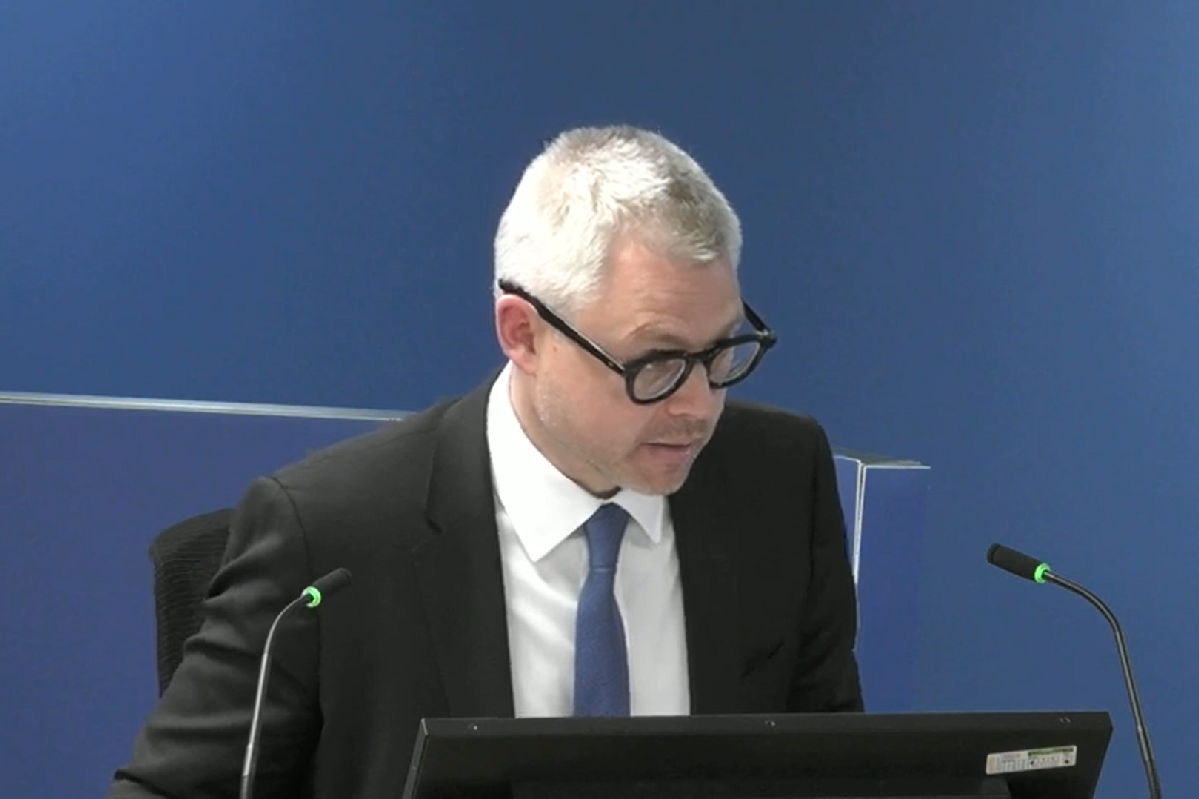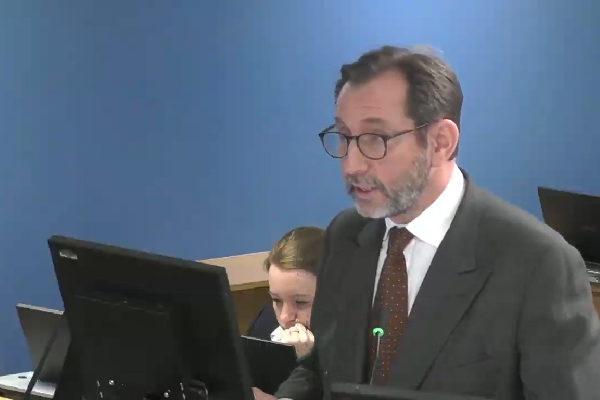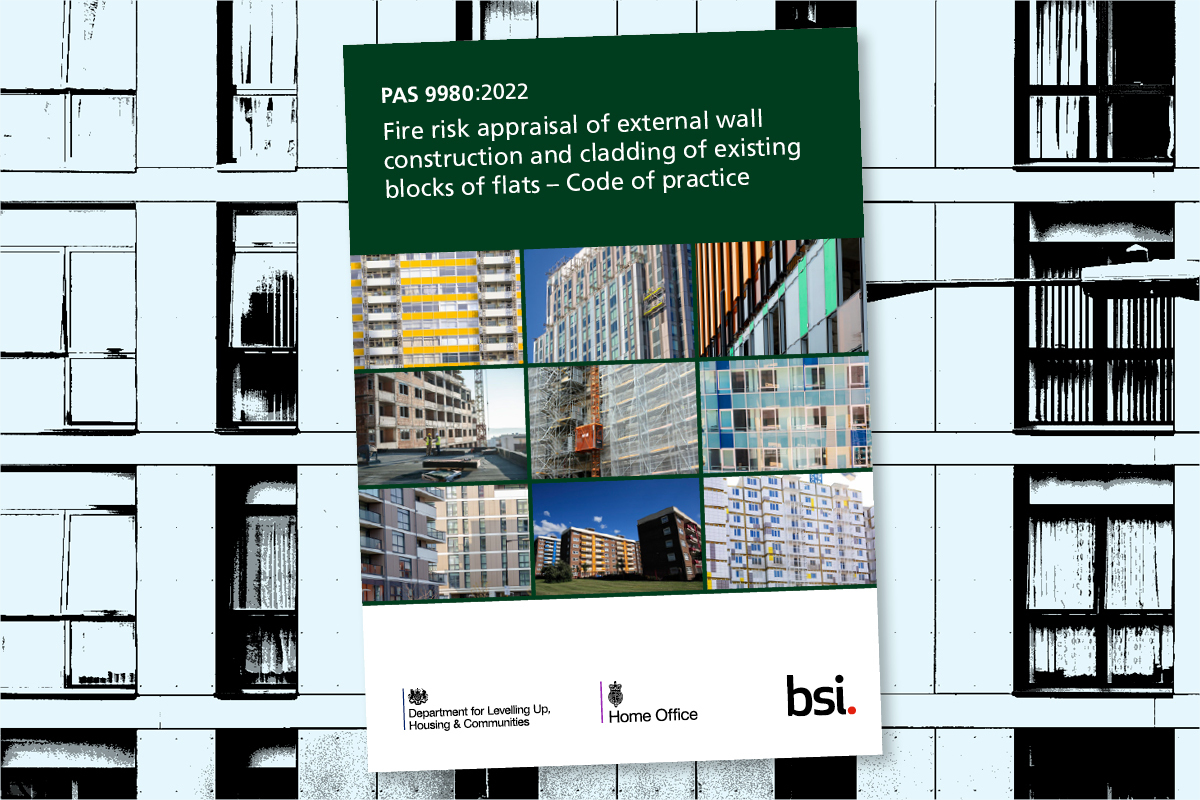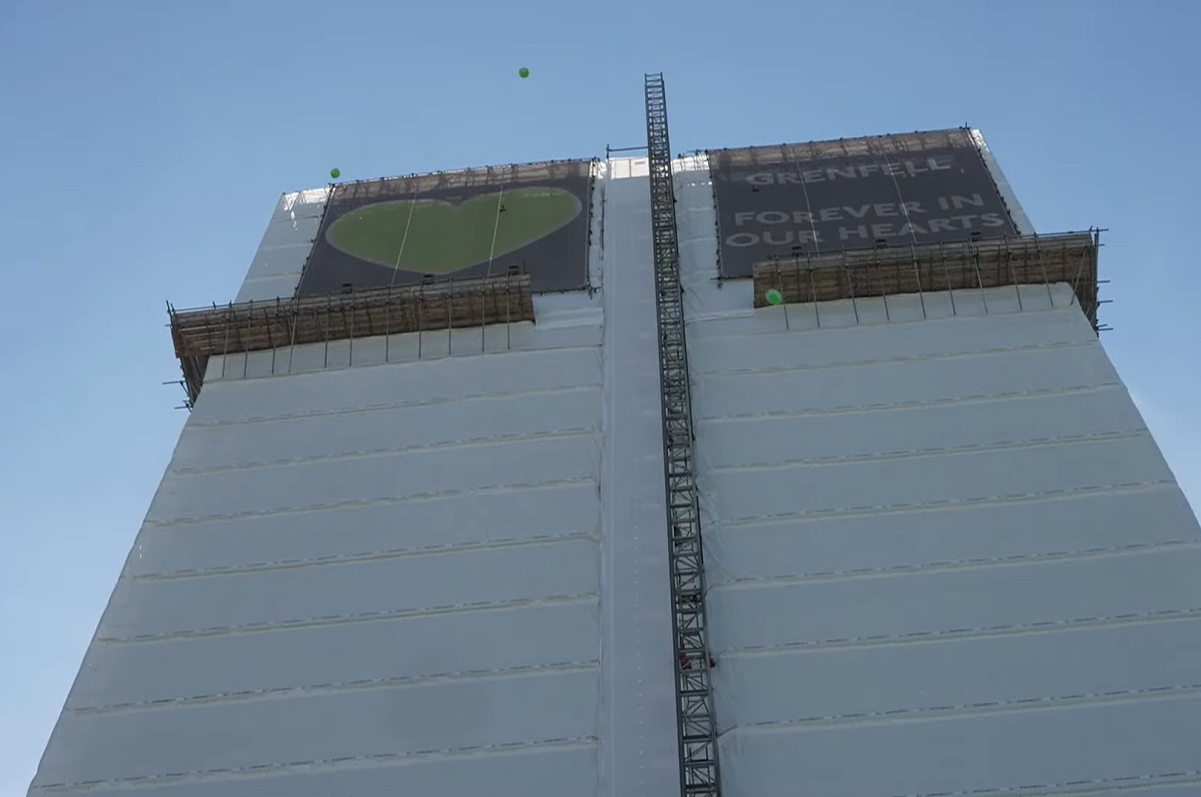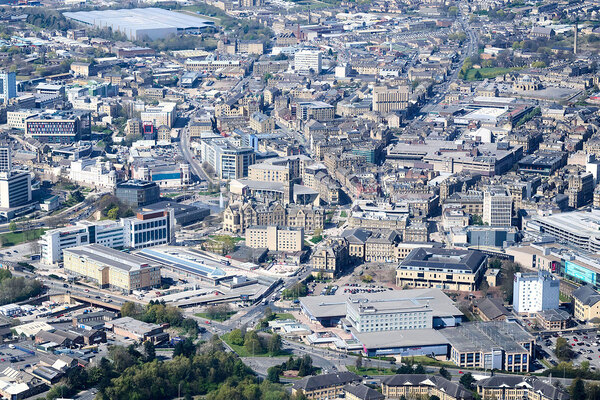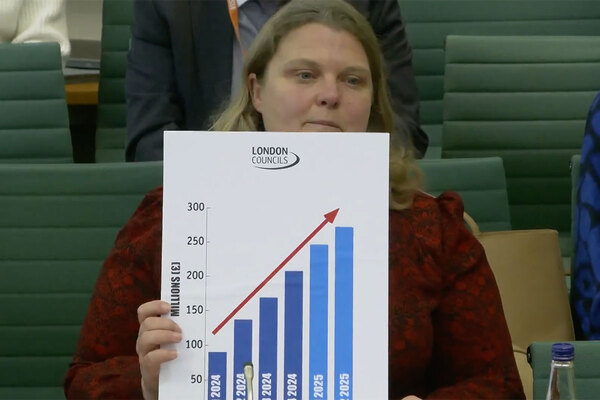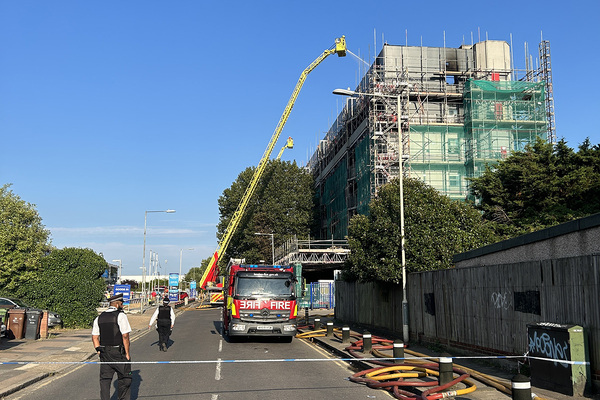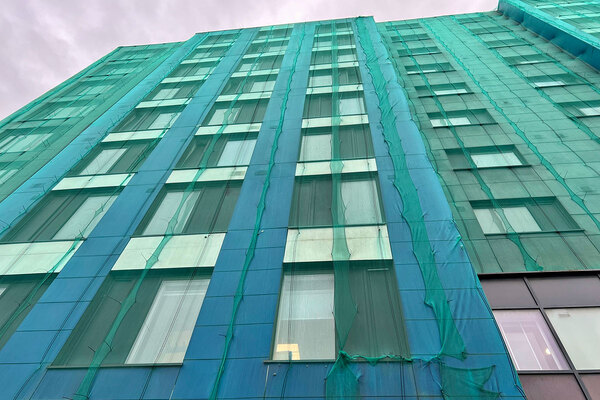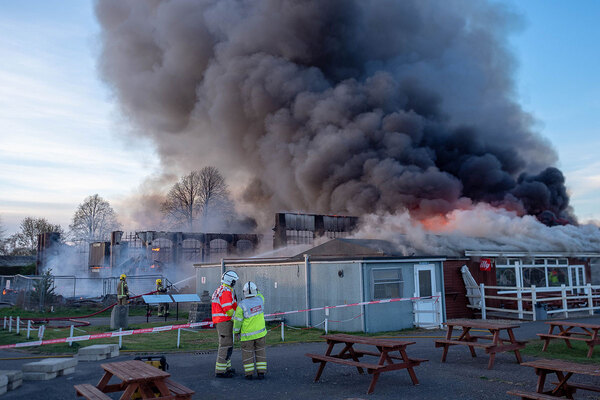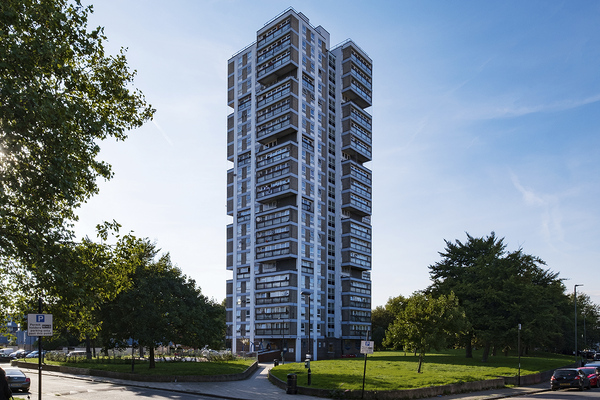Grenfell Tower Inquiry diary week 79: ‘You could argue that the system was created specifically to enable people to circumvent the rules’
The Grenfell Tower Inquiry continued to hear expert evidence this week, with two senior figures in the world of fire safety academia criticising the government’s approach before and after the blaze. Peter Apps and Grainne Cuffe report
Two expert witnesses gave evidence this week: Professors José Torero and Luke Bisby, who were questioned on the detail of their reports into the adequacy of building regulations and testing processes in the UK.
Both professors gave presentations last week, which you can read about here.
We will start our recap with the evidence of Professor Bisby.
‘You could argue that the system was created specifically to enable people to circumvent the rules’
In addition to his report on testing and the materials used on the tower, Professor Bisby (pictured above) also presented a review of regulations in the UK.
In a section titled ‘The Path to Grenfell’, he ran through what he described as “missed opportunities” to prevent the disaster.
Professor Bisby was clear at the beginning that in doing this, he was stepping outside his normal area of expertise. He said that while he did not “hold myself out as a social scientist”, he did have a “a demonstrated academic interest” in the area.
His conclusions were damning. Describing the move to a ‘performance-based’ system in the 1980s, as part of a flagship deregulation package delivered by Margaret Thatcher, he wrote: “In an effort to increase the ‘freedom’ of industry, the regulatory system became more permissive. No regulatory mechanism was put in place to ensure that those dispensing fire safety advice had the requisite competencies.”
“I mean, you could argue that the system was created specifically to enable people to circumvent the rules,” he told the inquiry.
The new regulatory system, which persists to this day, made it a legal requirement for builders to achieve standards such as that external walls “adequately resist” the spread of fire, but ultimately left it to their judgement as to how this should be done.
“At what point would you know, to a reasonable degree of certainty, whether or not you had met the functional requirement?” asked Richard Millett QC, lead counsel to the inquiry.
“In practical terms?” replied Professor Bisby. “If you had a big fire and everything went horribly wrong.”
He pointed to a warning from veteran fire scientist HL Malhotra, who wrote in 1986: “It will be perhaps another two or three decades before the consequence of this approach can be seen.”
“Because severe fires are thankfully rare, it might take a long time in order for the chinks in the armour, if you like, to manifest,” Professor Bisby said. “I mean, when I found this quote, I thought, ‘Wow, yeah, spot on.’”
‘I think it’s impossible to overstate the importance of what was missed here’
Turning to the specific missed opportunities, Professor Bisby was particularly critical of the response to the Knowsley Heights fire in 1991. This blaze occurred in a Merseyside tower block, which had been fitted with rainscreen cladding during a government-funded and monitored pilot scheme for what was then pioneering technology.
But at 2am on 5 April 1991, arsonists set light to a pile of rubbish that had built up outside the new cladding system. A firefighter who arrived at the scene said the blaze was “the most frightening thing any of us had ever seen as firefighters”, as “flames were coming from every landing window between the ground floor and the roof” of the 11-storey building.
In the years that have followed, Knowsley Heights has been a major event in our understanding of cladding fires in the UK.
The belief had been that it involved non-combustible materials, but allowed fire to spread through the gap (or cavity) between the external cladding and the insulation, which effectively served as a chimney.
Professor Bisby said this was his understanding of the fire. “The problem at Knowsley was [believed to be] the absence of cavity barriers. That’s what I believed. That’s what I was told… that’s the narrative of Knowsley,” he said.
This has driven a focus on cavity barriers in UK guidance, which has continued through the remediation programmes that have occurred post-Grenfell.
The trouble is, it is based on at best a serious mistake and, at worst, a deliberate cover-up.
The cladding on Knowsley Heights was not non-combustible at all. In fact, it was made of a product called ‘Cape Stenni’, glass-reinforced plastic panels, which would burn in a fire.
This, as the inquiry has heard, was not made apparent in the official report on the fire written by the Building Research Establishment (BRE).
Professor Bisby described himself as “speechless” when he realised this.
“I find it surprising (and alarming) that nobody appears to have taken an explicit and active interest in 13 the combustibility of the [cladding],” he wrote.
“I’ve tried quite hard to understand why [it] was not mentioned,” he told the inquiry.
“Have you found an answer?” asked Mr Millett (pictured above).
“No,” replied Professor Bisby.
What made the combustibility of the cladding particularly alarming was that it had a fire rating of ‘Class 0’, which meant it was installed in compliance with the government’s non-mandatory guidance, Approved Document B.
So the fire was actually startling evidence that this guidance was deficient and needed to be tightened. As the inquiry has heard repeatedly over the past six months, this was not done until after the Grenfell Tower fire.
“If, after Knowsley someone had stood up and said, ‘Well, actually, a significant proportion of the adverse outcome at Knowsley was because we had a Class 0 combustible rainscreen’, then maybe we wouldn’t have had many other fires, including Grenfell Tower,” said Professor Bisby.
“I think it’s impossible to overstate the importance of what was missed here.”
Why was it missed? Inside Housing has previously revealed the existence of a handwritten memo, referring to instructions from central government to “play down the issue of the fire”.
Professor Bisby said he had “tried quite hard to think of an alternative reason, other than what we might call the potential for embarrassment or the self-interest of the parties”, but had been unable to.
His written report addressed several other missed warnings, many of which have been discussed with witnesses from the government.
Importantly, Professor Bisby said the fact that the government had “opted to make no changes or clarifications to the guidance” as a result of the Lakanal House fire, which killed six in 2009, “can only be viewed as demonstrating a total failure of the system of building regulation”.
Broadly, he said there have been “powerful commercial and ideological incentives to increase complexity [in building regulations], while also increasing flexibility for industry”.
“It would take the deaths of 72 people at Grenfell Tower to motivate government into withdrawing Class 0 and into disrupting industry's status quo,” he wrote.
‘I think what it does is it helps people to feel that they have the competence, when in reality they don’t’
Discussing the specifics of fire tests and their place in the regulatory system used in the UK more specifically, Professor Bisby was asked about the practice of ‘desktop studies’ before the Grenfell Tower fire.
This involved an analysis of a proposed cladding system, based on a test on a different system.
Professor Bisby’s view was that this process in itself was not a problem. As the cladding tests were not representative of real-world systems, any use of them required some analysis and interpretation.
So desktop studies were, in a sense, an inevitable part of a system based on testing.
What he did take issue with was the competency of some of those who carried out the assessments.
Asked about one which accepted the use of the cladding panel later used on Grenfell on a different building, Professor Bisby said it was “particularly upsetting”. “I don’t use the word incompetent lightly, but it’s, from my perspective, it’s an utterly incompetent report,” he said.
He also raised significant concerns about the government’s new guidance to risk assessors who will examine the safety of building facades: PAS 9980 (pictured above).
His report said the document “neither clearly defines what is meant by competent, nor provides much assistance in terms of how this competence should be assessed, verified, maintained, controlled or monitored across the sector”.
He added that it “does little to raise the bar of the cladding fire risk assessment community and instead offers a formulaic methodology for undertaking such assessments”.
“I also believe that it should be recognised that the existence of PAS 9980 could perhaps counterintuitively generate risk that fire risk assessors who lack the requisite competence might be given a false sense of competence and might, therefore, use PAS 9980 to undertake cladding fire risk assessments they or their professional indemnity insurance might otherwise refuse,” Professor Bisby said.
“I think what it does is it helps people to feel that they have the competence, when in reality they don’t, and that’s why I think it’s dangerous,” he added.
‘The UK is a global outlier when it comes to stay put’
Professor Torero, a professor of civil engineering at University College London with significant international experience and recognition in the fire safety field, continued his evidence to the inquiry this week.
Last week he presented a report which concluded it was “essential” that the stay put policy for high-rise buildings is “abandoned” because the risk of fires spreading externally cannot be properly assessed under current methods.
He also criticised the primary test method for facades in the UK regulatory system, saying it does not provide “any meaningful measure” for real-world fire performance.
This week he was questioned on his findings.
On Wednesday, Professor Torero was asked about international fire safety regulations in comparison with the UK, with a focus on the US, Dubai and Australia.
The inquiry heard that both Dubai and Australia took action in response to the Grenfell Tower fire, while the US already has very “rigid” fire safety regulations in place.
It also heard that the US does not have a presumption of stay put and “requires some form of evacuation at all levels”, while Dubai abandoned the stay put policy with a new code of practice in 2018 following Grenfell and is now mandating an evacuation strategy, usually this is ‘phased’, meaning the building is evacuated in stages.
It heard that Australia, which changed building safety laws in response to the Grenfell fire, had already been having discussions on the issue after a serious cladding fire in a Melbourne apartment block in 2014. No one was hurt after the building was evacuated.
“Thinking about the position currently globally: how common would you say that phased evacuation approach is?” asked Kate Grange QC, counsel to the inquiry.
Professor Torero responded: “If you take high-rise buildings in general, I would say most countries will have a provision for a phased evacuation for high-rise buildings.
“In countries like the UK, that provision will exist for office buildings, but not for residential.
“But I think to a great majority, you will have a provision for a staged evacuation also in residential buildings around the world.”
“So to what extent is this jurisdiction an outlier, at the moment, in retaining a stay put strategy?” asked Ms Grange.
“I think the UK is an outlier in the sense of its rigidity. So there is no alternative – in that sense it is truly an outlier. Even in countries where they have retained a significant number of situations in which stay put is acceptable, they will have a provision that in case it’s not, you can move it to a plan B,” replied Professor Torero.
He added: “I will say that where the UK is truly an outlier is in the absence of alternative provisions.”
Professor Torero also said: “This is a matter that deserves rigorous analysis, because I still haven’t found any reason why a stay put strategy is beneficial or necessary. There is no technical reason for that.”
The inquiry heard that though each US state has its own regulations, a national body called the National Fire Protection Association (NFPA) “exercised huge influence” in the way that fire safety is implemented across the country.
It heard that the US follows higher standards of fire safety, including through use of sprinklers, phased evacuations and putting two staircases in buildings.
The US has a similar large-scale fire test – NFPA 285 – to the one in the UK: BS 8414.
In a submission to the inquiry about the regulatory system in the US, the NFPA said: “[The NFPA 285] test is similar to BS 8414 and is mandated for use predominantly on high-rise buildings where a combustible component may make up part of the building’s exterior wall assembly.
“Having a rigorous test is not enough to control the fire risk. It’s important to ensure that what is specified as well as installed is the same as what is tested.”
Professor Torero said that the NFPA 285 was used in an otherwise “rigid” system in the US, whereas in the UK, the test is open to interpretation.
“If you have a complicated situation that has multiple variables and you’re incorporating that into a system that allows multiple solutions, the possibility of making a mistake is enormous,” Professor Torero explained.
On Thursday, he gave extensive evidence about fire safety tests.
He concluded that the UK’s testing system is “extremely far away” from where it should be.
Professor Torero said the BS 8414 test – named after the standard which contains its methodology – is limited in scope, while the results of the tests are often interpreted in an over-simplistic way.
The inquiry was shown a document called Fire Performance of External Cladding Systems, which is a new British standard, published in 2019, which looks at how to extrapolate results from these tests and attempts to bring some structure to the pre-Grenfell process of desktop assessments.
Asked to describe the document, he called it “an absolute oversimplification of a complex problem that is full of mistakes from beginning to end”.
Professor Torero explained that efforts to standardise these assessments were misguided, when what is required is a “base bespoke assessment” of the building which the cladding system is being installed on.
He agreed that he is “very critical” of the guidance as it substitutes a desktop study “which should be conducted by a competent professional” with simple tables.
Professor Torero said: “Yes. I think that you will find that there is a recurring theme in all my reports, that I’m extremely critical of any document that substitutes competency and that’s what this document does.”
“Because what you’re saying is these systems, these processes, they’re far, far too complicated to be able to be simply understood or interpreted by reference to simple tick-box tables, essentially,” stated Ms Grange.
Professor Torero agreed.
He concluded in his report that the current fire-related performance assessment of materials and systems associated with the design and build of the building envelope in the UK is “flawed”.
He wrote: “The conclusions also indicate that the manner in which the building regulations presume to deliver fire safety is also flawed.”
He said it is also “not clear” what the required competency is for a professional to be able to establish the fire performance of a building envelope.
Professor Torero explained: “Building envelopes are therefore currently designed in a manner that does not allow fitness for purpose to be established with any certainty.
“Existing testing practices have little capacity to deliver the necessary data for an adequate performance assessment.
“As a consequence, existing testing practices place an unrealistic expectation on professionals because they do not deliver appropriate and sufficient data for the required assessment.”
Asked later how he would describe the competency of fire safety engineering professionals in this country when making assessments of external wall performance, he said it was “extremely poor”.
“But I would rather describe it as we have an enormous confusion of competency. I think we’ve got to the point where we really cannot assess in a credible way who is competent and who is not,” he said.
Asked why simply banning combustible cladding is not an answer, he said any ban would only be a partial ban.
“If you really wanted to implement the perfect ban, everything would have to be non-combustible… we know that that is not possible,” Professor Torero explained.
He added that a partial ban would create a “false sense of safety”.
Professor Torero said a “true solution” to the problems related to fire safety testing systems in the UK will require a “complete reassessment” of the manner in which fire safety is perceived by the construction industry, which will take “significant time”.
He said it is therefore “essential” that short-term improvements are implemented in the meantime.
“How far away is our testing regime from where it ought to be if it is to deliver the kind of data and information which competent professionals can use to make appropriate assessments about these external wall systems?” asked Ms Grange.
Professor Torero said that from a “fundamental perspective, it’s extremely far away”.
“In essence, if we were to think properly and make once and for all the decision that we are going to go in the direction of functional requirements and we create the framework that supports that, then we could actually work with the tests that we have, modify them, use them in a way such that they could provide meaningful information,” he added.
Eighteen green balloons
The week’s evidence paused on Tuesday, as the Grenfell Tower community came together to mark the fifth anniversary of the fire.
A multi-faith memorial service was held at the base of the tower, followed by a silent walk around the streets of the area, which was attended by an estimated 16,000, many of which dressed in green.
A common theme of speakers both at the memorial service was the ongoing lack of justice, with one Islamic leader saying the sound the community needed to hear was “the click of handcuffs”.
“This is a message to the government and it better break through: regulate them or we regulate you,” rapped Lowkey, an artist who comes from the area, lost friends in the fire and closed the speeches following the march with a performance.
Earlier during the ceremony, 18 green balloons were released – one for each of the children killed in the fire.
Ayesha, aged eight, a survivor of the fire, who was three when it occurred, read a poem she had written called Never Forget.
She said: “I will never forget the fire.
“I will never forget the smoke.
“I will never forget the sirens
“I will never forget how scary the fire was.
“I will never forget that I survived.
“I will never forget my friends and my neighbours who didn’t survive.
“We can’t change the past, but we can change the future.
“We will stay strong, we will rise up as a community.
“We will fight for justice together.
“We will always remember our friends and our neighbours.
“We will always remember our homes.
“We can’t change the past, but we can change the future. Never forget.”
The inquiry continues.
Grenfell Tower Inquiry week 79: headlines
UK global ‘outlier’ on ‘stay put’, expert tells Grenfell Inquiry
The UK is a global outlier when it comes to the ‘stay put’ policy, a fire safety expert has told the Grenfell Tower Inquiry.
The government’s desire to increase the “freedom” of the construction industry led to a pre-Grenfell system of regulation which “perpetuated and encouraged” guidance being “misapplied and exploited in the service of generating profit whilst avoiding liability”.
UK guidance on how to interpret current large-scale fire tests on cladding is “full of mistakes from beginning to end”, a fire expert told the Grenfell Tower Inquiry.
Sign up for our weekly Grenfell Inquiry newsletter
Each week we send out a newsletter rounding up the key news from the Grenfell Inquiry, along with the headlines from the week
Already have an account? Click here to manage your newsletters
Grenfell Tower Inquiry phase two: weekly diaries
Module one: the refurbishment
Week one: A vivid picture of a broken industry
After a week of damning revelations at the opening of phase two of the Grenfell Tower Inquiry, Peter Apps recaps the key points
Click here to read the full story
Week two: What is the significance of the immunity application?
Sir Martin Moore-Bick has written to the attorney general requesting protection for those set to give evidence at the Grenfell Tower Inquiry. Peter Apps explains what the move means
Click here to read the full story
Week three: Architects of misfortune
This week saw the lead architects for the Grenfell Tower refurbishment give evidence to the inquiry. Peter Apps runs through the key points
Click here to read the full story
Week four: ‘I didn’t have any perception that it was the monster it’s become’
The architects continued to give evidence this week, outlining a lack of understanding of the fire risk posed by the cladding materials and its design. Nathaniel Barker reports
Click here to read the full story
Week five: ‘No adverse effect in relation to external fire spread’
As the Grenfell Tower Inquiry returns from its long absence, Peter Apps recaps the key points from a week of important evidence from the fire consultants to the refurbishment
Click here to read the full story
Week six: ‘I can’t recall any instance where I discussed the materials with building control’
Nathaniel Barker summarises what we learned from fire engineers Exova, architects Studio E and the early evidence from contractor Rydon
Click here to read the full story
Week seven: ‘I do not think I have ever worked with a contractor operating with this level of nonchalance’
Two key witnesses from contractor Rydon gave evidence this week. Peter Apps recaps some of the key points from a revealing week of evidence
Click here to read the full story
Week eight: ‘It haunts me that it wasn't challenged’
Four witnesses from contractor Rydon gave evidence this week. Lucie Heath recaps what we learned on the last week of evidence before the inquiry breaks for five weeks
Click here to read the full story
Week nine: ‘All I can say is you will be taken out for a very nice meal very soon’
This week the inquiry heard evidence from witnesses at Harley Facades, the sub-contractor responsible for Grenfell Tower’s cladding. Peter Apps recaps the key points
Click here to read the full story
Week 10: ‘As we all know, ACM will be gone rather quickly in a fire!’
As the Grenfell Tower Inquiry entered its 10th week, Jack Simpson recaps the key points from a week of important evidence from the refurbishment’s cladding contractor
Click here to read the full story
Week 11: ‘Did you get the impression Grenfell Tower was a guinea pig for this insulation?’
With witnesses from the cladding subcontractor, the firm which cut the deadly panels to shape and the clerk of works which inspected the job giving evidence this was week full of revelations. Peter Apps recaps the key points
Click here to read the full story
Week 12: ‘Would you accept that was a serious failing on your part?’
With the surveyor who inspected Grenfell Tower for compliance giving evidence, this was a crucial week from the inquiry. Dominic Brady and Peter Apps report
Click here to read the full story
Week 13: ‘Value for money is to be regarded as the key driver for this project’
With consultants to Kensington & Chelsea Tenant Management Organisation (KCTMO) giving evidence, attention at the Grenfell Tower Inquiry turned for this first time to the actions of the TMO and the council. Peter Apps reports
Click here to read the full story
Week 14: ‘Did it not occur to you at this point that your budget was simply too low?’
This week, for the first time in phase two, the inquiry heard from Kensington & Chelsea Tenant Management Organisation, the landlord that oversaw the fatal refurbishment of Grenfell Tower. Lucie Heath reports
Click here to read the full story
Week 15: ‘Have you ever informed the police that you destroyed documents relevant to their investigation?’
Witnesses from the Kensington and Chelsea Tenant Management Organisation (KCTMO) gave evidence for a second week, which began with a shocking revelation about withheld and destroyed evidence. Peter Apps recaps
Click here to read the full story
Week 16: ‘I conclude this was very serious evidence of professional negligence’
This week saw members of Kensington & Chelsea Tenant Management Organisation finish giving evidence, before the inquiry’s expert witnesses took the stand to make some highly critical assessments of the work they had seen before and during the refurbishment of Grenfell Tower. Jack Simpson recaps
Click here to read the full story
Grenfell Tower: a timeline of the refurbishment
Following the conclusion of module one of the Grenfell Inquiry’s second phase, Peter Apps presents a timeline of the key moments during the fatal refurbishment of the west London tower block
Click here to read the full story
Module two: the cladding products
Week 17: ‘It’s hard to make a note about this because we are not clean’
The start of the second module of the Grenfell Tower Inquiry phase two came with some huge revelations about the companies that sold the products used in the cladding system. Peter Apps reports
Click here to read the full story
Week 18: ‘It was just reckless optimism wasn't it?’
As the inquiry began cross-examining witnesses for the second module of its phase two work, the picture surrounding just how Grenfell Tower ended up wrapped in such dangerous materials became a little clearer. Nathaniel Barker was keeping an eye on proceedings
Click here to read the full story
Week 19: ‘And that was intentional, deliberate, dishonest?’
The Grenfell Tower Inquiry this week heard the shocking story of how the insulation manufacturer “manipulated” official testing and marketed its product “dishonestly”. Peter Apps tells the story
Click here to read the full story
Week 20: ‘We were outed by a consultant who we then had to fabricate a story to’
This week the inquiry investigated the actions of Kingspan – the manufacturer of one of the insulation products used in the tower’s cladding system. Dominic Brady reports
Click here to read the full story
Week 21: ‘It’s there in black and white isn't it? We see a complete absence of any consideration of life safety’
The story of insulation giant Kingspan’s testing and marketing of its combustible insulation for high rises was unpacked in minute detail this week. Peter Apps reports
Click here to read the full story
Week 22: ‘All we do is lie in here’
In the third week of evidence from insulation giant Kingspan, the inquiry continued to uncover shocking details about the firm’s behaviour both before and after the Grenfell Tower fire. Lucie Heath reports
Click here to read the full story
Week 23: ‘That would have come as an earthquake to you at the time, would it not?’
This week the inquiry took its deepest dive yet into the inner workings of the cladding manufacturer whose product has been blamed for the terrible spread of fire up Grenfell Tower. Nathaniel Barker reports
Click here to read the full story
Week 24: ‘Do you accept that Test 5B was Arconic's deadly secret’
The president of the firm that made and sold the cladding panels installed on Grenfell Tower was asked to account for the apparent concealment of “disastrous” fire tests on the product this week. Peter Apps reports
Click here to read the full story
Week 25: ‘This is quite an incredible list of omissions and missed instances, isn’t it?’
This week the Grenfell Tower Inquiry heard its first witnesses from the Building Research Establishment (BRE) - the testing house which carried out key fire tests on the Kingspan and Celotex insulation products which were later used on Grenfell Tower. Peter Apps reports.
Click here to read the full story
Week 26: 'You were taking an enormous risk, weren't you?'
Week 26 at the Grenfell Tower Inquiry was a key moment in understanding how dangerous products used on the tower came to be accepted by industry professionals. Dominic Brady reports
Click here to read the full story
Week 27: ‘What will happen if one building made out [of] PE core is in fire and will kill 60 to 70 persons?’
The most explosive evidence this week at the Grenfell Tower Inquiry came from those who did not attend, as the evidence which would have been presented to Arconic witnesses was displayed in their absence. Peter Apps reports
Click here to read the full story
Week 28: ‘This is a serious safety matter’
This week the Grenfell Tower Inquiry zeroed in on the British Board of Agrément, the body that produced “misleading” certificates which inspired trust in both the cladding and insulation used on the tower. Lucie Heath reports
Click here to read the full story
Week 29: ‘Is it true that Kingspan’s position… was to do its best to ensure that science was secretly perverted for financial gain?’
The final week in this section of the Grenfell Tower Inquiry primarily examined the attempts by insulation manufacturer Kingspan to lobby government after the fire. Peter Apps reports
Click here to read the full story
How the products used in Grenfell Tower's cladding system were tested and sold
As the section of the Grenfell Tower Inquiry examining how the products used in the cladding system were tested, marketed and sold comes to a close, Peter Apps summarises what we have learned about each of the products included in the system
Click here to read the full story
Module Three: the management of the tower
Week 30: ‘There is certainly a high probability that in the event of a fire the whole building can become an inferno’
The focus of the inquiry shifted this week to the actions of the social housing providers responsible for maintaining Grenfell Tower. Pete Apps recaps what we learned
Click here to read the full story
Week 31: ‘If we cannot get out people will die’
This week saw the former residents of Grenfell Tower enter the witness box to tell of their experiences attempting to raise complaints with the council and its managing agent. Pete Apps reports
Click here to read the full story
Week 32: ‘Let's hope our luck holds and there isn't a fire’
This week saw the return of the landlord of Grenfell Tower, Kensington and Chelsea Tenant Management Organisation (KCTMO), as senior staff members attempted to explain how vital fire safety protections at the block were allowed to fall into disrepair. Lucie Heath reports
Click here to read the full story
Week 33: ‘Isn't that a serious gap in the scope of a policy meant to safeguard vulnerable people?’
A slightly disjointed week at the Grenfell Tower inquiry saw further evidence from staff at building manager Kensington and Chelsea Tenant Management Organisation (KCTMO) interspersed with the views of a cladding expert. Peter Apps reports
Click here to read the full story
Week 34: ‘Some members of the community are doing their best to spread false information’
Jack Simpson covers all the major revelations from the past week of evidence at the Grenfell Inquiry, including evidence from Laura Johnson, director of housing at the Royal Borough of Kensington and Chelsea.
Click here to read the full story
Week 35: ‘I really didn’t like the champagne’
This week the Grenfell Tower Inquiry saw council witnesses, including former deputy leader Rock Feilding-Mellen and leader Nicholas Paget-Brown, questioned about their role in the story for the first time. Peter Apps reports
Click here to read the full story
Week 36: ‘Is that not a very incurious approach for a fire risk assessor?’
This week the Grenfell Tower Inquiry scrutinised the work of Carl Stokes, the man hired to carry out fire risk assessments for the block. Nathaniel Barker reports
Click here to read the full story
Week 37: ‘In giving that advice, weren’t you acting beyond your knowledge and expertise?’
A curtailed week at the Grenfell Tower Inquiry saw fire risk assessor Carl Stokes grilled over advice he gave regarding the tower’s cladding. Peter Apps reports
Click here to read the full story
Week 38: ‘Well it’s a bit more than that, isn’t it. He’s suggesting that you tell the LFB a lie’
The inquiry heard the mammoth cross-examination of KCTMO’s health and safety manager Janice Wray this week. Peter Apps reports
Click here to read the full story
Week 39: ‘What you said there was a grotesque understatement’
This week the inquiry continued to hear from former employees of Kensington and Chelsea Tenant Management Organisation, as well as two employees from the London Fire Brigade. Lucie Heath reports
Click here to read the full story
Week 40: ‘An exercise in concealment and half-truth’
Former KCTMO chief executive Robert Black gave his evidence to the inquiry this week and was asked to account for the various failures described over the previous six weeks. Peter Apps and Nathaniel Barker report.
Click here to read the full story
Week 41: ‘We should do nothing. This is not the sort of website we should be responding to’
This week saw the return of Robert Black, chief executive of Kensington and Chelsea Tenant Management Organisation (KCTMO), before the inquiry turned its attention to the defective smoke control system in the tower. Dominic Brady reports
Click here to read the full story
Week 42:‘They would leak as much as they leaked. They were what they were’
The Grenfell Tower Inquiry continued its in-depth investigation of the tower’s non-compliant smoke control system this week, with evidence from the various contractors involved in delivering it. Pete Apps reports
Click here to read the full story
Week 43:‘Contractors at the time were not generally aware of the importance of leaving holes unsealed’
This week the inquiry focused on two of the more overlooked areas of the Grenfell Tower fire, with evidence focusing on the gas pipelines and lifts within the west London block. It was a packed week, with five witnesses giving evidence. Jack Simpson reports
Click here to read the full story
Week 44:‘I've never seen a fully compliant firefighting lift in any local authority building, to this day actually’
This week the inquiry turn the focus onto the building’s defective lifts, with evidence from an expert, contractors who worked on them and a former engineer at KCTMO. Pete Apps reports.
Click here to read the full story
Week 45: ‘Don’t you find all this rather a surprising debate, given that the Equality Act was passed in 2010?’
The inquiry heard from expert witness Colin Todd this week, who gave his views about the work of risk assessor Carl Stokes as well as answered questions about his own guidance. Peter Apps and Nathaniel Barker report
Click here to read the full story
Week 46: ‘I think I've been very, very clear that is completely wrong’
This week the inquiry heard further expert evidence about fire risk assessor Carl Stokes’ actions, as the section of its work covering the management and maintenance of the tower concluded. Peter Apps reports
Click here to read the full story
Six key failures in the way Grenfell Tower was managed before the fire
Peter Apps recaps some of what we have learned about the actions of the Royal Borough of Kensington and Chelsea (RBKC) and Kensington and Chelsea Tenant Management Organisation (KCTMO) in the years before the fire.
Module one and two closing statements
Week 47: ‘An unedifying spectacle’
After a week of closing statements from the core participants involved in modules one and two, Lucie Heath recaps the key arguments of each group
Click here to read the full story
Module five: the fire brigade
Week 48: ‘They knew, and lives could and should have been saved’
The phase of the Grenfell Tower Inquiry examining the actions of the London Fire Brigade in the years before the fire kicked off this week with some major revelations. Peter Apps reports
Click here to read the full story
Week 49: ‘I'm not sure we've always taken every opportunity to learn as an organisation’
How the London Fire Brigade acted upon lessons from incidents in the years before the Grenfell Tower disaster came under the microscope this week at the public inquiry. Nathaniel Barker reports
Click here to read the full story
Week 50: ‘There is a culture in LFB that is very conservative. I think there is great comfort in what is familiar’
This week the inquiry heard how the London Fire Brigade (LFB) elected not to issue warnings about dangerous cladding before Grenfell and a detailed examination of its policy for checking high risk buildings. Pete Apps reports.
Click here to read the full story
Week 51:‘We teach firefighters to expect building failure’
An unusually brief week of evidence at the Grenfell Tower Inquiry explored how a fire service neighbouring London was taking a different approach to tackling blazes in high rises. Nathaniel Barker reports
Click here to read the full story
Week 52: ‘I actually think that there is a measure of incompetence at all levels’
Expert evidence concluded the current section of the inquiry with some stinging criticism of the London Fire Brigade (LFB). Pete Apps and Grainne Cuffe report.
Click here to read the full story
Module six: fire services
Week 53: ‘They make for chilling reading and harrowing listening’
The inquiry’s investigation into central government began this week with lawyers setting out their view on how and why firefighting policies failed. Peter Apps and Lucie Heath report
Click here to read the full story
Week 54: ‘Our consideration of evacuation at this time was something of a blind spot’
The development of policy on ‘stay put’, both nationally and for London, occupied the attention of the inquiry this week. Peter Apps reports
Click here to read the full story
Week 55: ‘My review is pretty scathing!’
In a week that included the 200th day of evidence in phase two of the inquiry, attention turned to the London Fire Brigade’s control room. Lucie Heath reports
Click here to read the full story
Week 56: ‘Why didn't we thump the table harder’
This week, the control room at the London Fire Brigade was examined further – both before and after the fire. Pete Apps and Lucie Heath report
Click here to read the full story
Week 57: ‘It was worse than slow, it was sluggish’
Former London Fire Brigade (LFB) commissioner Dany Cotton was the star witness this week, as the inquiry continued to delve into the brigade’s knowledge and training before the Grenfell Tower fire. Jack Simpson, Grainne Cuffe and Pete Apps report
Click here to read the full story
Week 58: ‘I don't think we deserve to ask for trust until we demonstrate different outcomes’
A current and former commissioner of the London Fire Brigade (LFB) wrapped up the inquiry’s investigation into the actions of the brigade before the fire. Grainne Cuffe and Peter Apps report.
Module six: testing and government
One of the major scandals of our time: key revelations as the Grenfell Tower Inquiry turns to government
The government was accused of “covering up” the risks of dangerous cladding as its “unbridled passion for deregulation” left it a “junior party” to the construction industry as the latest phase of the public inquiry opened today. Peter Apps summarises some of the main points
Click here to read the full story
Week 59: ‘Recent tests have apparently shown it continued to burn for 20 minutes after the flame was taken away’
After shocking opening statements, the Grenfell Tower Inquiry turned its attention to the work of Local Authority Building Control. Pete Apps reports
Click here to read the full story
Week 60: ‘You could have an exact repeat of the Dubai fire in any number of buildings in London’
The Grenfell Tower Inquiry turned its attention to the work of the National House Building Council this week, with shocking revelations about the extent of the warnings issued to central government before the fire. Peter Apps reports
Click here to read the full story
Week 61: ‘Mistakes are meant for learning, not repeating’
In the first hearings of the new year, the Grenfell Tower Inquiry heard closing statements from the firefighting section of phase two. Lucie Heath reports
Click here to read the full story
Week 62: Did it ever occur to you that this act of collaboration was, in one sense, corrupting?
The Grenfell Tower Inquiry returned to the work of the National House Building Council (NHBC) this week, with a new shocking revelation about the government’s actions in the immediate aftermath of the fire. Peter Apps reports
Click here to read the full story
Week 63: ‘It came after the general move to deregulation. So more regulation was not welcome’
The government’s focus on deregulation before the Grenfell Tower fire was placed in the spotlight this week with a series of shocking revelations about its failure to amend fire safety guidance. Pete Apps and Grainne Cuffe report
Click here to read the full story
Week 64: ‘I didn’t think ACM would be suitable for use in any high-rise buildings. I don’t think anyone did’
This week, the Building Research Establishment’s Dr Sarah Colwell gave more than three days of evidence, with some huge revelations about what was known about the dangers of aluminium composite material years before the fire and the mass confusion over the government’s building regulations. Peter Apps and Jack Simpson report
Click here to read the full story
Week 65: ‘Unless the government does something now about ACM panels, people will die’
Further evidence from the Building Research Establishment and the first government witnesses added new depth to our understanding of how warnings were missed before the Grenfell Tower fire. Peter Apps reports
Click here to read the full story
Week 66: ‘Was there a cover-up?’
The latest evidence from the Grenfell Tower Inquiry tracked the government’s failure to act on fire safety warnings right up until the months before the fire. Peter Apps and Grainne Cuffe report
Click here to read the full story
Week 67: ‘When exposed to a fire, the aluminium melts away and exposes the polyethylene. Whoosh!’
This week the inquiry heard disturbing new evidence about the failure of senior government officials to act on warnings about dangerous cladding in the years before the Grenfell Tower fire. Peter Apps reports
Click here to read the full story
Week 68: ‘Can we agree that was a pretty dangerous thing to have, all this falling on one man’s shoulders?’
Three senior civil servants gave evidence this week, including the official who had responsibility for building regulations guidance on fire safety in the years before Grenfell. Peter Apps, Lucie Heath, Stephen Delahunty and Grainne Cuffe report
Click here to read the full story
Week 69: ‘It was just unthinkable. You had the makings here of a crisis you could not comprehend’
This week, civil servant Brian Martin gave his long-awaited evidence to the Grenfell Tower Inquiry. Peter Apps reports
Click here to read the full story
Week 70: ‘Show me the bodies’
An important week at the Grenfell Tower Inquiry saw a dramatic conclusion to the mammoth cross-examination of civil servant Brian Martin, as well as the first politicians. Peter Apps and Lucie Heath report
Click here to read the full story
Week 71: ‘I have changed my schedule to fit this in. I do have an extremely busy day meeting people’
Three politicians who were responsible for building regulations before Grenfell appeared before the inquiry this week, including the former communities secretary Eric Pickles, who responded to the coroner’s letter following the Lakanal House fire. Peter Apps and Lucie Heath report
Click here to read the full story
Module Four: aftermath
Week 72: 'The system isn't broken. It was built this way'
This week the inquiry turned to the shocking story of the lack of support for bereaved and survivors in the immediate aftermath of the Grenfell Tower fire. Peter Apps, Lucie Heath, Grainne Cuffe and Jack Simpson report
Click here to read the full story
Week 73: ‘Most people would regard that as hopeless’
This week, the Grenfell Tower Inquiry heard about the Royal Borough of Kensington and Chelsea’s chaotic response in the immediate aftermath of the blaze, from the staff responsible for it. Pete Apps, Stephen Delahunty and Grainne Cuffe report
Click here to read the full story
Week 74: ‘Do you agree that RBKC was ill-prepared and incapable to meet its duties’
This week, Nicholas Holgate, former chief executive of the Royal Borough of Kensington and Chelsea, was grilled on his failure to hand over control of the aftermath of the fire, despite the borough’s lack of capacity. Peter Apps reports
Click here to read the full story
Week 75: ‘It still shocks me to the core that that’s how we treat our citizens in this country’
This week the inquiry heard witnesses from the housing management body discuss their role in the aftermath of the Grenfell Tower fire, followed by a range of witnesses from other organisations which supported the response. Peter Apps and Grainne Cuffe report
Click here to read the full story
Week 76: ‘I fear this will become our New Orleans’
This week the inquiry heard from central government figures and members of the London-wide emergency response arrangements. Peter Apps and Grainne Cuffe report
Click here to read the full story
Week 77: ‘The planning wasn’t done and there was nothing for us to be drawing on’
The Grenfell Tower Inquiry’s examination of the aftermath of the fire concluded with witnesses from central government. Peter Apps reports
Click here to read the full story
Module seven: expert evidence and closing statements
Week 78: ‘The abandonment of the ‘stay put’ strategy for high-rise residential buildings is essential’
This week the Grenfell Tower Inquiry heard a range of expert witnesses discuss their reports. Peter Apps and Grainne Cuffe report
Click here to read the full story
Week 79: ‘You could argue the system was created to enable people to circumvent the rules’
The Grenfell Tower Inquiry continued to hear expert evidence this week, with two senior figures in the world of fire safety academia criticising the government’s approach before and after the blaze. Peter Apps and Grainne Cuffe report
Click here to read the full story
Week 80: ‘The evidence points to wilful blindness and complacency towards safety’
As the inquiry moves into its final stages, lawyers for the key players gave statements about the evidence surrounding central government. Peter Apps reports
Click here to read the full story
Week 81: ‘This is Islamophobia. It’s racism. It is the elephant staring back at us in the room’
This week, closing statements covering the aftermath of the fire delivered a shocking new revelation and an expert toxicologist gave his views on the causes of the deaths. Peter Apps reports
Click here to read the full story
Module eight: further evidence relating to the deceased
Week 82: ‘Their chance to hear about the circumstances in which their loved ones died is the culmination of five years of waiting’
The Grenfell Tower Inquiry moved into its final module this week, with evidence relating to the circumstances in which the victims died. Peter Apps reports
Click here to read the full story
Week 83: ‘They died together as they lived: caring for one another’
A second week of evidence relating to the circumstances in which the victims of the fire died delivered more heartbreaking stories about their final moments. Peter Apps recaps
Click here to read the full story
Week 84: ‘Every decision affects someone who is an adored child, a beloved sister, a respected uncle, a needed mother’
The final week of oral evidence for the Grenfell Tower Inquiry’s second phase contained more heartbreaking evidence about the deaths in the tower. Peter Apps reports
Click here to read the full story
Closing statements
Week 85: ‘The merry-go-round turns still, the notes of its melody clearly audible in the last few days’
The Grenfell Tower Inquiry returned this week for closing statements from lawyers representing the bereaved and survivors and the various parties under scrutiny for the fire. Pete Apps reports.

